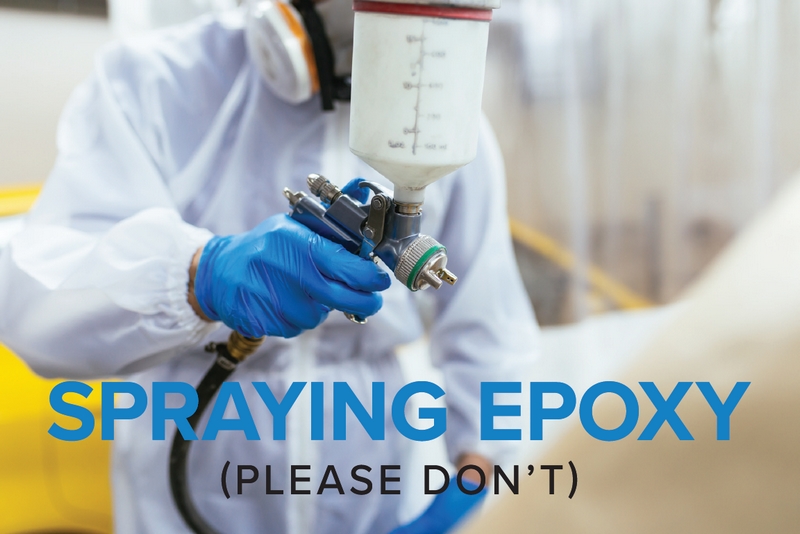
Please Don’t
By Rachael Geerts—GBI Composite Materials Engineer
Every year we get questions regarding how to spray WEST SYSTEM® Epoxy. Some people want to know how to thin epoxy so it comes out of a spray gun better while others want to know what Personal Protective Equipment (PPE) is required for spraying epoxy safely. We give them all the same answer: Don’t do it! In short, epoxy is extremely hazardous when sprayed.
Why You Shouldn’t Spray Epoxy
To spray epoxy it must be atomized. This means the tiny epoxy molecules will be airborne. You might be saying to yourself, “Of course the particles of epoxy have to be small enough to be airborne Rachael, that’s the definition of spraying it.” Consider other materials you are used to spraying: hairspray, sunscreen, bug spray, just to name a few. Yet, how much of these relatively less hazardous aerosols do you really want to inhale?
To make matters worse, in order to reduce the viscosity of the epoxy enough for a spray gun to atomize it, you must thin the epoxy with a solvent. In general, we don’t recommend thinning the epoxy with solvents as they can decrease the cured properties. In high enough loadings, solvents can affect every stage of the epoxy curing process.
No Sufficient Protection
To play devil’s advocate, let’s say you thinned the epoxy with a low loading of a common solvent. Now, you not only have to concern yourself with the health and safety effects of the atomized epoxy, but also those of atomized solvent. “That’s okay Rachael, I’ve worked with other fiberglass resins that I’ve sprayed so I know I have to wear a mask.” A mask, even an N-95 or a full face mask, isn’t going to protect you from atomized epoxy. Also, a mask only theoretically prevents you from inhaling the epoxy; it doesn’t prevent absorbing epoxy through your skin.
Perhaps you could find a pressurized suit with air provided (not generated, provided) from an outside source. That would help you in the immediate application but then you also have to understand how solvents affect the epoxy’s curing reaction time.
Beware the Green Stage
The epoxy curing reaction is very slow compared to polyester, vinyl ester, or the glues used in spray tack and hairspray. WEST SYSTEM 105 Resin® with 205 Fast Hardener® takes about 60 minutes to gel in a thin film (~1/16″ or ~63 mils thick). That means for at least 60 minutes, atomized epoxy that hasn’t yet reached the tacky state can float around the room. Then there are another 6-8 hours during which the epoxy is trying to cure to a solid-state we call the green stage. It’s when epoxy has enough cross-link density to become solid but is still reacting chemically. The 6-8 hour mark is when the green stage begins, assuming your solvent hasn’t affected that too much, not when the green stage ends. The epoxy could stay green for hours to days later. Walking into the shop while atomized epoxy is in the green stage can kick up these tiny particles. Without a pressurized suit with an external air source hooked up, these epoxy particles pose serious health effects including skin sensitization, respiratory tract irritation or burns, or, as if those weren’t enough, chemical pneumonia.
Overspray of Atomized Epoxy
If you have ever spray-painted something then you know how much overspray there can be, and that’s with a product designed to settle to the surface within 5 or 10 minutes of spraying it. Think of how far small, atomized epoxy particles can travel with that nice summer breeze blowing through the shop, or through the heating system when you’re working in the garage or the basement in the winter.
For the sake of this example, let’s limit the overspray radius to six feet. Now when the epoxy has cured, everything within six feet of the edge of your project is coated with a thin layer of epoxy.
We appreciate our customers and want you to be successful. Contracting chemical pneumonia or having everything in your shop coated with epoxy is not “success” in our book.
The Good News
You don’t need to spray epoxy to get a solid repair or a great-looking part. Just visit westsystem.com and follow our tips on how to properly apply epoxy. Still have questions? Call our Technical Staff weekdays from 9:00 AM to 5:00 PM EST at 886-937-8797 (toll-free).





